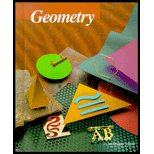
Concept explainers
a)
To find: The theorem that is converse to said theorems 5.1.
a)
Answer to Problem 9WE
Theorem 5.4 is converse of theorem 5.1, that states that If both pairs of opposite sides of a quadrilateral are congruent, then quadrilateral is a parallelogram.”
Explanation of Solution
Given information: Statements of following theorem is given,
Theorem 5.1: “Opposite sides of a parallelogram are congruent.’
Concept used: Converse of a theorem is a statement that is formed by interchanging the given section of a theorem by what to prove and what to prove section by given section of the theorem.
Calculation: On observing different sections given, it is found that the converse to theorem 5.1 is theorem 5.4 that’s statement is, “If both pairs of opposite sides of a quadrilateral are congruent, then quadrilateral is a parallelogram.”
Conclusion: Thus, theorem 5.4 is the converse of given theorem 5.1.
b)
To find: The theorem that is converse to said theorems 5.2.
b)
Answer to Problem 9WE
Theorem 5.6 is converse of theorem 5.2, that states that If both pairs of opposite
Explanation of Solution
Given information: Statements of following theorems are given,
Theorem 5.2: “Opposite angles of a parallelogram are congruent.”
Concept used: Converse of a theorem is a statement that is formed by interchanging the given section of a theorem by what to prove and what to prove section by given section of the theorem.
Calculation: On observing different sections given, it is found that the converse to theorem 5.2 is theorem 5.6 that’s statement is, “If both pairs of opposite angles of a quadrilateral are congruent, then the quadrilateral is a parallelogram.”
Conclusion: Thus, theorem 5.6 is the converse of given theorem 5.2.
c)
To find: The theorem that is converse to said theorems 5.3.
c)
Answer to Problem 9WE
Theorem 5.7 is converse of theorem 5.3, that states that “If the diagonals of a quadrilateral bisect each other, then the quadrilateral is a parallelogram.”
Explanation of Solution
Given information: Statements of following theorems are given,
Theorem 5.3: ”Diagonals of a parallelogram bisect each other.”
Concept used: Converse of a theorem is a statement that is formed by interchanging the given section of a theorem by what to prove and what to prove section by given section of the theorem.
Calculation: On observing different sections given, it is found that the converse to theorem 5.3 is theorem 5.7 that’s statement is, “If the diagonals of a quadrilateral bisect each other, then the quadrilateral is a parallelogram.”
Conclusion: Thus, theorem 5.7 is the converse of given theorem 5.3.
a)
To find: The theorems that are converse to said theorems 5.1,5.2 and 5.3.
a)
Answer to Problem 9WE
Theorem 5.4 is converse of theorem 5.1, theorem 5.6 is converse of theorem 5.2 and theorem 5.7 is converse of theorem 5.3.
Explanation of Solution
Given information: Statements of following theorems are given,
Theorem 5.1: “Opposite sides of a parallelogram are congruent.’
Theorem 5.2: “Opposite angles of a parallelogram are congruent.”
Theorem 5.3: ”Diagonals of a parallelogram bisect each other.”
Concept used: Converse of a theorem is a statement that is formed by interchanging the given section of a theorem by what to prove and what to prove section by given section of the theorem.
Calculation: On observing different sections given, it is found that the converse to theorem 5.1 is theorem 5.4 that’s statement is, “If both pairs of opposite sides of a quadrilateral are congruent, then quadrilateral is a parallelogram.”
Converse to theorem 5.2 is theorem 5.6 that’s statement is, “If both pairs of opposite angles of a quadrilateral are congruent, then the quadrilateral is a parallelogram.”
Converse to theorem 5.3 is theorem 5.7 that’s statement is, “If the diagonals of a quadrilateral bisect each other, then the quadrilateral is a parallelogram.”
Conclusion: Thus, theorem 5.4, theorem 5.6 and theorem 5.7 are the converse of given theorems.
Chapter 5 Solutions
McDougal Littell Jurgensen Geometry: Student Edition Geometry
Additional Math Textbook Solutions
Calculus Volume 1
Probability And Statistical Inference (10th Edition)
Differential Equations and Linear Algebra (4th Edition)
A First Course in Probability
Probability and Statistical Inference (9th Edition)
Finite Mathematics for Business, Economics, Life Sciences and Social Sciences
 Elementary Geometry For College Students, 7eGeometryISBN:9781337614085Author:Alexander, Daniel C.; Koeberlein, Geralyn M.Publisher:Cengage,
Elementary Geometry For College Students, 7eGeometryISBN:9781337614085Author:Alexander, Daniel C.; Koeberlein, Geralyn M.Publisher:Cengage, Elementary Geometry for College StudentsGeometryISBN:9781285195698Author:Daniel C. Alexander, Geralyn M. KoeberleinPublisher:Cengage Learning
Elementary Geometry for College StudentsGeometryISBN:9781285195698Author:Daniel C. Alexander, Geralyn M. KoeberleinPublisher:Cengage Learning

